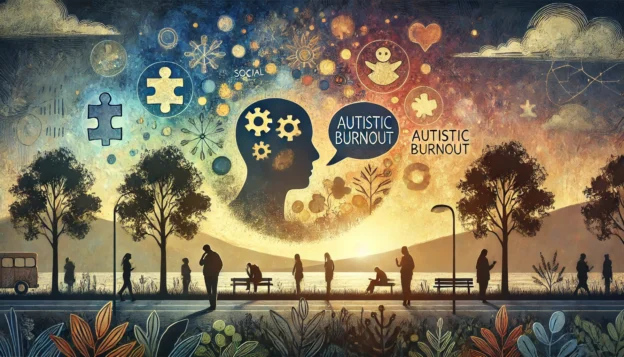This article examines Social Communication Disorder (SCD) and Autistic Burnout within the context of autism spectrum disorder (ASD). SCD, introduced in the DSM-5 in 2013, involves persistent difficulties in verbal and nonverbal social communication, distinct from autism as it lacks restricted and repetitive behaviours. Autistic burnout, characterized by chronic exhaustion and loss of skills due to prolonged stress and masking of autistic traits, highlights the impact of environmental pressures on autistic individuals. The article explores the intersection and divergence between SCD and autistic burnout, emphasizing the need for differentiated and supportive interventions to improve the quality of life for autistic individuals.
Introduction
This article delves into two critical aspects of autism spectrum disorder (ASD): Social Communication Disorder (SCD) and Autistic Burnout. It provides a historical context for both terms, describes each concept in detail, and discusses their similarities and differences. The article also explores how these concepts intersect or oppose each other, concluding with a subjective opinion on their implications for understanding and supporting autistic individuals.
Social Communication Disorder (SCD)
Social Communication Disorder (SCD), added to the DSM-5 in 2013, is characterized by persistent difficulties with verbal and nonverbal communication in social contexts. These challenges include problems with social interaction, social cognition, and pragmatics, using language in proper contexts. SCD involves difficulties in responding to others, using gestures, taking turns in conversation, and adjusting speech according to the situation. Unlike autism, SCD does not include restricted and repetitive behaviors (Autism Speaks, 2021).
The introduction of SCD aimed to address individuals who exhibit social communication issues without the broader characteristics of autism. This differentiation is essential for appropriate diagnosis and intervention, as it helps distinguish between SCD and ASD, ensuring that individuals receive the specific support they need (SpringerLink, 2021).
Autistic Burnout
Autistic Burnout is a state of chronic exhaustion, loss of skills, and heightened sensory sensitivity, resulting from prolonged stress and a mismatch between personal capacities and external demands. It is often triggered by continuous efforts to mask autistic traits and meet societal expectations, leading to physical and mental fatigue, reduced functional capacity, and increased anxiety or depression (National Autistic Society, 2023).
Autistic burnout highlights the significant impact of environmental and social factors on the well-being of autistic individuals. It underscores the need for supportive environments that accommodate autistic needs and reduce the pressures that contribute to burnout (Wikipedia, 2023).
Intersections and Divergences
Both SCD and autistic burnout deal with social communication challenges, but from different angles. SCD focuses on inherent communication difficulties in social contexts, while autistic burnout results from external pressures and the continuous effort to mask these difficulties.
While SCD and autistic burnout can coexist, they highlight different aspects of the autistic experience. SCD pertains to the fundamental social communication impairments present from an early age, whereas autistic burnout typically emerges later, often due to chronic stress and social demands exceeding the individual’s coping abilities.
Conclusion
Understanding SCD and autistic burnout is crucial for creating a more inclusive and supportive environment for autistic individuals. Differentiating between inherent communication challenges and stress-induced burnout can lead to more effective interventions. It is essential to provide tailored support that addresses both the social communication needs and the environmental modifications required to prevent burnout.
Promoting awareness of autistic burnout can help reduce the stigma associated with autistic behaviours and encourage the development of more accommodating social and professional environments. This holistic approach can significantly enhance the quality of life for autistic individuals.
